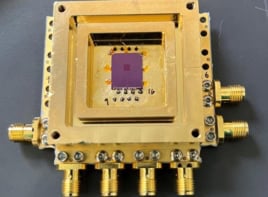
Physicists in the US have developed an analogue of a superconducting quantum interference device (SQUID) that replaces the superconductor with a Bose–Einstein condensate and measures rotation rather than magnetic flux. They hope that the research will lead to the development of new, ultra-sensitive gyroscopes.
The SQUID is a well-established and extremely sensitive device for measuring magnetic fields that has found a range of commercial applications. At its heart is a loop of superconductor broken by one or two Josephson junctions. These are thin barriers of non-superconducting material that superconducting pairs of electrons are able to tunnel across. SQUIDs rely on the fact that superconducting electrons are all represented by the same wavefunction, which extends around the loop and includes the junctions. This means that the current that flows around the loop – and therefore the magnetic flux through the loop – is quantized at discrete values. If the magnetic flux in the loop increases or decreases, there is an oscillation in the voltage across the Josephson junctions every time the magnetic flux changes by one quanta. These quanta are very small and therefore an extremely small change in magnetic flux can be measured by counting the voltage oscillations.
A Bose–Einstein condensate (BEC) resembles a superconductor because it is a collection of ultracold atoms that is represented by the same wavefunction and flows as a superfluid without mechanical resistance. If a BEC is confined in a loop, the superfluid can flow around forever – at least in principle – and the angular momentum of the BEC is quantized much like current is quantized in a superconductor loop.
Torus of atoms
In this latest work Gretchen Campbell and colleagues at the University of Maryland and the National Institute of Standards and Technology used two infrared laser beams to confine a BEC of sodium atoms in a torus. They used a third green laser beam – which repels the condensate – to cut the ring at one point (see figure). This cut is analogous to a Josephson junction in a SQUID – the wavefunction remains continuous but the atoms must tunnel across.
The team then rotates the laser cut around the torus, which allows the researchers to “stir” the condensate. When the laser is moved slowly through the BEC, the atoms tunnel “backwards” through the cut so that the BEC’s angular-momentum state does not change. But once the laser goes above a certain speed, the tunnelling current is not sufficient to conserve angular momentum and the condensate undergoes a “phase slip”. This involves atoms tunnelling through the beam in the opposite direction, which causes a change in the angular-momentum state. Similar phase slips occur again as the laser beam is speeded up further and the BEC shifts between angular-momentum states.
Measuring rotation
“At the end of the day, the laser beam is playing the same role as the Josephson junction in a SQUID,” explains Campbell. “The only difference is that since rotation is analogous to having a magnetic field, we actually have to rotate the barrier.” As such, if the set-up itself is rotated, the effect is similar to exposing a SQUID to an external magnetic field and therefore the system could be used to make very sensitive measurements of rotation.
This is not the first time that a superfluid has been used to measure rotation. Quantum gyroscopes use liquid helium to make incredibly sensitive measurements of, for example, the rotation of the Earth. Campbell believes the new set-up has a significant advantage over superfluid-helium gyroscopes. “Since our junctions are just made with laser beams, we can tune those junctions,” she says. This could make a gyroscope more sensitive, she suggests, because altering the power of the green laser beam affects the critical angular velocity at which a phase shift occurs. The researchers are now studying in more detail precisely how the condensate behaves in the optical trap to allow them to tune it effectively.
Condensed-matter physicist Augusto Smerzi at the University of Florence in Italy agrees that the work could produce interesting applications, but he is more intrigued by the researchers’ observations about the breakdown of superfluidity when the condensate is stirred too quickly. There are several competing theories about how this happens, he explains, but researchers suspect that it involves the formation of vortices in the condensate’s structure called topological excitations. “This work gives one of the first demonstrations of the formation of these vortices when the superfluidity breaks down,” he says.
The research is described in Physical Review Letters.



